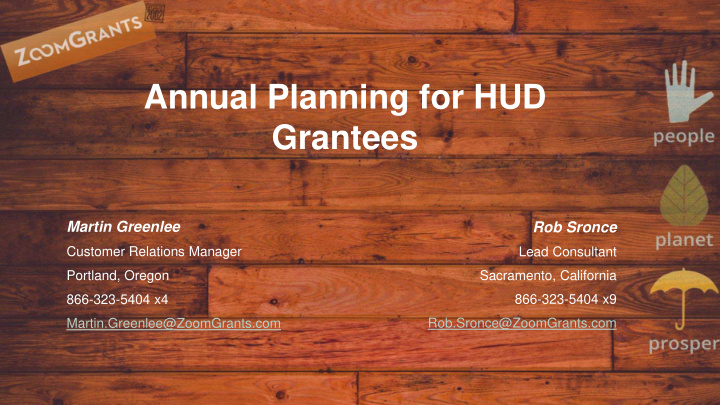



Annual Planning for HUD Grantees Martin Greenlee Rob Sronce Customer Relations Manager Lead Consultant Portland, Oregon Sacramento, California 866-323-5404 x4 866-323-5404 x9 Martin.Greenlee@ZoomGrants.com Rob.Sronce@ZoomGrants.com
Session Goals • Our Mission: Improve the practice of grants management. • The annual planning process can take a lot of time and money. – Public information and engagement can be one of the most costly components. • Questions for the planning process. – Are we being efficient and effective? – Are we doing more than we need to do? – What can we do better? • Enjoy what we do!
This is what we’d like to see.
This is what we fear will happen.
This is what actually happens.
What are we supposed to do? • Requirements are at 91.100 and 105 • The e-Con Plan Citizen Participation Toolkit (2014) • Basic requirements – Encourage participation • Specific groups and persons must be reached • General public and stakeholders – Inform the public – Provide opportunity for comment • Your Citizen Participation Plan – What is in here, really?
What are we doing? • We asked you! • Sent out 400+ emails • Got 36 responses (sound familiar?) • Had a few follow-up conversations. • Our own experience as grantee staff, consultants, and partners in the annual planning process.
Survey says!
• Who responded – 2/3 cities, 1/3 counties, handful consortia – All CDBG, ¾ HOME, less than half ESG, handful of HOPWA – Over 70% submitted a five- year Con Plan in 2015
• Communicating Program Information – What we use. – What is effective. – Are we effective?
• Engaging the Public – How do we do it? – Which means are effective?
• Our planning process is effective. • We are using the most effective tools.
• Deciding who and what is funded. – Competitive – Scoring • Many hands – Elected or appointed – Management and staff • Annual process with annual awards
So what have we learned?
Informing the Public • We take a shotgun approach. (Hoping to hit the target?) – Desperation or design? • In- person meetings are still in use and “trusted.” – Preference, tradition, requirement? • “Highly effective” grantees use email and website. – Actual or perceived? • Social media is a non-starter. Why? – Labor intensive or prohibited? • Self assessment is “meh.”
Engaging the Public • We sure seem to like those meetings. – Measured or we experience engagement? • Surveys are “just ok” we thinks. – This “should” be a powerful tool. Are we targeting? • The “public hearing” is not the best means. – This is one of the required means and it’s less than effective? – When are we holding them? • We give ourselves a luke warm score.
Slicing up the pie. • Process and structure vary. – As many forms as grantees. • Nearly all of us are confident in our process. – Effective use of funds. Transparent and accountable. • Types – Staff-driven – Committee/Commission – Hybrid
What little treasures did we find?
What have we here? • There is a good portion who think the website is not effective. – The media or the method? – Many government websites are very poorly designed and used. • There are methods some use even when “not effective.” – Meetings, web, survey. Why keep using them? • Public hearings don’t seem to serve a purpose. – Only holding (and noticing) because required? – Get in front of HUD? • Social media is DOA? – High maintenance? Fear-based policy?
The Community Workshop • The “Fall of 2014,” a tale of two cities. – Authentic engagement vs. “what’s the score?” • Take the meeting to the people. – Stakeholder groups (like your COC) – Neighborhood groups • A viable year-round structure. – “Pop - up” doesn’t work – Be part of a larger participatory planning and budgeting process – Use your committee or commission
Websites need to work. • Can’t be effective if the experience is sub -par. – Anything short of easy. • Design and use. – Mobile-friendly – Text on the page, not hosted documents to download. – Simplify navigation, part of a larger design effort. – Dynamic and living. • Push the public to the website. – If nothing else, Twitter and Facebook point to the website.
Email is essential • The million dollar mess. – Two spreadsheets, a Word doc and forwarded email. • Email is “sticky.” – Email can tell you when it’s opened and clicked. – Manage your email: MailChimp, ConstantContact … • Use it with a purpose – Direct to the website – Ask for action
Have a readable document. • Deviate from the eCon Plan template. – You don’t need to publish in this format. – Consider web-friendly, web only – Review the regs and talk to your CPD Rep • Charts and tables. • Discuss how activities were selected. – Transparent and accountable. • Publish early, track comments, revise and re-publish.
Use a committee to guide your process.
Have a standing committee. • Year-round focus on oversight and guidance. – Legitimacy, accountability, and transparency. – Many hands make light the work. – Take the spotlight off of staff. • A time and place for citizen participation. – Year-round conversation. – Mid-year adjustments (timeliness) – Advocates for the process.
Bits and pieces • Schedule – Leave room for participation – Change up the order • Year-round process – Keep CDBG in front of decision-makers. – Lessen the boom and bust. • Branding programs and projects. – Signage and program materials
Have goals and strategy. • There is no single solution. • Think critically about what you are doing and why. – Look at the regs – Have a conversation with local leadership • Revisit the requirements. – Not enough? Too much? • Make planning a year-round process. – And informing the public, and engaging citizens
Let’s discuss!
866-323-5404|Sales@ZoomGrants.com|https://ZoomGrants.com
Recommend
More recommend